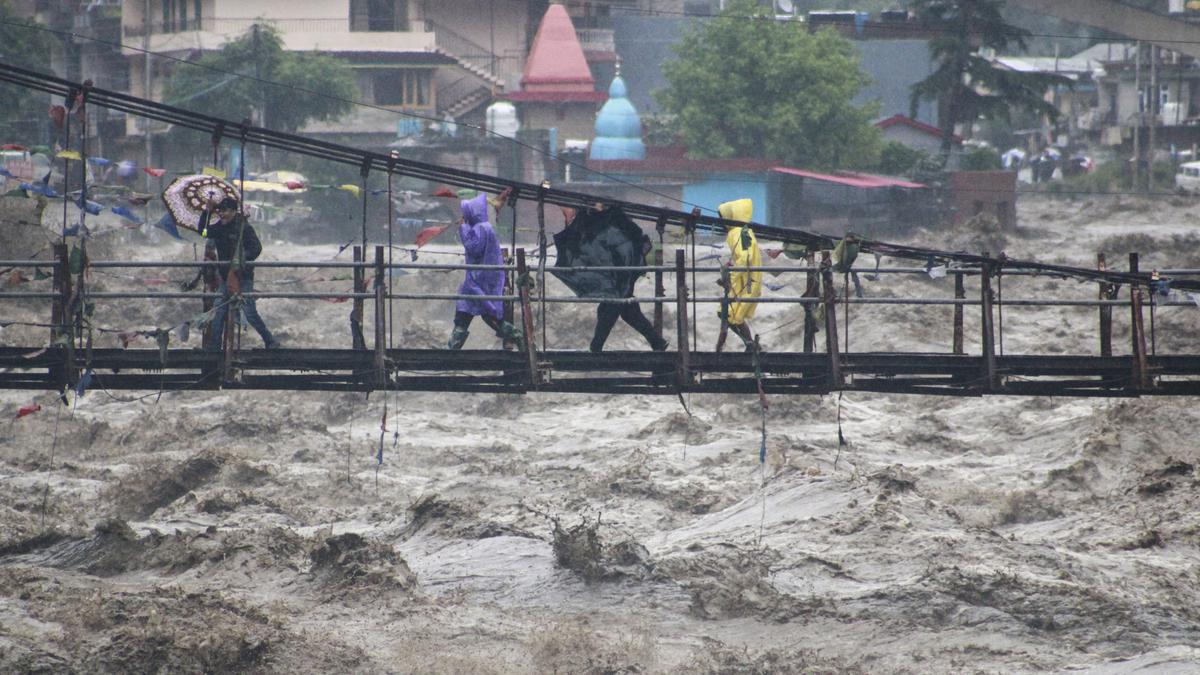
Explained | Himachal floods: a man-made disaster?
The Hindu
Himachal Pradesh's development model led to improved social welfare, but liberalisation caused exploitation of natural resources. Uncontrolled hydropower projects, road expansions and agricultural shifts have caused flash floods. A Commission of Inquiry is needed to empower local communities and rebuild assets quicker. Climate change must be addressed with infrastructure planning to avert disasters.
The story so far: Flash floods during this year’s monsoon season have caused unprecedented damage to both lives and assets in Himachal Pradesh. The death toll has crossed 150, and the estimated total loss amounts to ₹10,000 crore. Although climate change is expected to have played a hand in causing the high precipitation leading to these flash floods, human induced disasters resulting from planned development have played a significant role in causing such colossal losses. In the last five years (before 2022), 1,550 people lost their lives and nearly 12,444 houses were damaged.
The IPCC (Intergovernmental Panel on Climate Change) VI report has clearly stated that the Himalayas and coastal regions of India will be the hardest hit by climate change. In the Himalayas, there is a noticeable pattern of increased precipitation occurring in shorter periods of time. The India Meteorological Department data shows that the normal rainfall during this period is expected to be between 720mm and 750 mm. However, in certain instances, it has exceeded 888 mm in 2010 and 926.9 mm in 2018. This year, the precipitation so far has been attributed to the combined effect of the south-west monsoon with western disturbances. The total rainfall from June to date was 511 mm.
Apart from climate change, anthropogenic factors have also significantly contributed to the disaster. The State’s development model initiated after it came into being in 1971 had been successful in transforming Himachal Pradesh into an exemplar of development for mountain States. This model, known as the Dr. Parmar model (named after the founding Chief Minister, Dr. Y.S. Parmar), focused on exemplary land reforms, robust state-led investment in social welfare, and a strong emphasis on human resources. These efforts resulted in Himachal Pradesh ranking second in social development indices. By the 1980s, electricity had reached every household, there was improved connectivity in remote areas through health care centres, many schools came up, there were major advancements in agriculture, and a shift towards the apple and off-season vegetable economies fostered both economic and social vibrancy.
However, the advent of liberalisation led to significant changes, with the Central government demanding stringent fiscal reforms and mountain States being forced to generate their own resources for fiscal management. What were these resources? The exploitation of natural resources, including forests, water, tourism, and cement production, became a major focus for development. This led to the rapid construction of hydropower projects, often causing damage to rivers and their ecosystems, widening of roads without proper geological and engineering assessments, expansion of cement plants altering land use patters, and a shift in agricultural practices to cash crop economies that affected the landscape and river systems.
The pursuit of hydropower projects became a dominant focus for hill States, with their capacity measured in terms of megawatts (MW) to attract investments. Notably, there was a significant shift in funding priorities of multilateral agencies. Prior to 2000, these agencies were opposed to financing large hydropower projects, but they changed their stance and started providing funding for such ventures, making finance readily available for these projects.
One of the main reasons for the devastating impact of floods in the region is the uncontrolled construction of these hydropower projects, which have essentially transformed mountain rivers into mere streams. The technology employed, known as “run of the river” dams, diverts water through tunnels burrowed into the mountains, and the excavated material (muck) is often disposed of along the riverbeds. During periods of higher precipitation or cloudbursts, the water returns to the river, carrying the dumped muck along with it. This destructive process is evident in rivers like Parvati, Beas and Sutlej, as well as many other small hydropower dams. Moreover, long tunnels spanning 150 km have been planned or commissioned on the Sutlej river causing significant harm to the entire ecosystem.
Currently, there are 168 hydropower projects in operation, generating 10,848 MW of electricity. Looking ahead, it is projected that by 2030, 1,088 hydropower projects will be commissioned to harness 22,640 MW of energy. This surge in hydropower projects raises concerns about the inevitability of impending disasters in the region.





















 Run 3 Space | Play Space Running Game
Run 3 Space | Play Space Running Game Traffic Jam 3D | Online Racing Game
Traffic Jam 3D | Online Racing Game Duck Hunt | Play Old Classic Game
Duck Hunt | Play Old Classic Game











